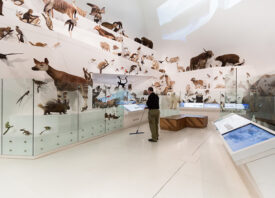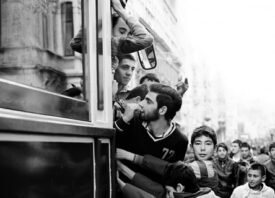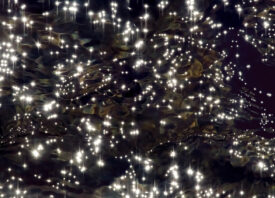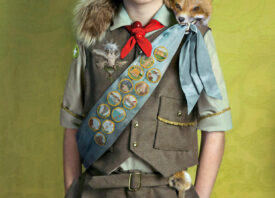Search this site
Gowns Made from Rubbish Bring Awareness to the Most Polluted Creek in Melbourne

“The sounds at Merri Creek are the beautiful sounds of the bush in Victoria: Wattlebirds singing, Pobblebonk frogs calling in spring, the wind in the gum leaves,” the photographer Daisy Noyes tells me. “But the smells at the Merri Creek are definitely urban: Sewage overflow, oil run-off, the smell of stormwater drains, and detergents and chemical waste from factories upstream all contribute to the poor water quality. It’s the most polluted creek in Melbourne, and you can smell this.”
Then there’s the rubbish. When it rains, trash and litter flow from the storm drains and into the creek. “It collects on all the reeds, branches, and trees,” Noyes explains. “After a flood, it’s incredible how much of it is swirling around the creek, especially now that the pandemic has meant canceled cleanups and more single-use plastic. Sometimes, the bushes and reeds on the bank of the creek look like they’ve been decorated with rubbish by the river.”
Noyes has been collecting and repurposing some of that rubbish for her ongoing series, Merri Creek Dresses. For the project, she’s made wearable dresses from plastic bags, aluminum cans, HDPE bottles, and more. Some she created using invasive weeds. She returns to Merri Creek to photograph herself, adorned in the frocks, at the site where the litter was found.
So far, one of her friends has also modeled gowns made of rubbish. So have her children, who will someday inherit the ecological crises we leave behind. In her pictures, Merri Creek becomes a 21st-century Garden of Eden, a paradise contaminated. We asked her more about this long-term body of work.

Can you tell me a bit about your relationship with Merri Creek? What makes this place special to you?
“The Merri Creek is the only real bushland in the northern suburbs of Melbourne that I can get to on foot. It’s a long sliver of wild land on either side of the creek that snakes through so many different environments, from rural farmland to urban factories to suburbia. In Brunswick East and Coburg, where I live, the bike trails on each side of the creek offer a beautiful way to be in nature while getting a walk in or riding bikes with my kids.
“During lockdown, it became a daily pilgrimage, with my kids riding bikes and building jumps and me photographing. Every day is different at the creek. It rises and floods with rain; different plants are flowering at different times. It’s a place where the seasons and the constant changes of nature are so visible, even though we are right in the middle of Melbourne.
“My earliest memories of the Merri Creek are from when I first moved to Melbourne and became a mother, and I walked along the creek with my toddler. I grew up in a rural area of New York State, and I always assumed I would raise my own kids on a farm too. So when we ended up having children in a city, it was always so soothing and meaningful to me to walk down to the creek, noodle around in the grass, throw sticks in the water, and be amongst the native bushland. Being in the bush is so different from a park or playground: play is open-ended and creative, the environment is always changing, and there’s a sense of wildness.”

Might you tell us a bit about the history of this land?
“From my research, the traditional custodians of the Merri Creek and surrounding land were the Wurundjeri people of the Kulin nation. The creek was a major source of food and resources, and the spot where the Merri meets the Yarra River was an important meeting place. The name Merri Creek comes from the Woiwurrung word ‘Merri Merri,’ which means very rocky.
“After European invasion and settlement, the creek became an easy way to divert waste from the tanneries, quarries, abattoirs, and later, factories that were built on its banks. But in recent decades, groups like CERES, the Merri Creek Management Committee, and Friends of the Merri Creek have overseen enormous improvements with native plantings, regeneration of habitats, and cleaning up rubbish.”
How did the idea for this series first begin to take shape?
“I was taking a bag down with me most days and collecting rubbish and then throwing it in a bin on the way home, and the idea popped into my head to make something with this resource and photograph it. I wanted to express my dismay at the sheer amount of junk that accumulates in the creek and talk about how we are leaving this and other environmental catastrophes for the next generation to deal with. I realized that if I made a dress from the rubbish and wore it at the creek, and photographed it, that this could be a kind of visual representation or essay about this issue.”
Do you make the dresses yourself? What does that process look like?
“The first dress I made was really haphazard and full of holes, as I hadn’t yet figured out how to work with the plastic. I just taped it all together on an old mannequin my son had found. The next dresses were made with reeds, and one with prickly pear cactus, both of which are invasive weeds that degrade the creek environment, and these were made by sewing the reeds and cactus pieces onto an old dress.
“They were quite fun to do, but I think the final effect wasn’t delivering the message as strongly as the plastic rubbish does, so I went back to that, and made three more with plastic waste, cans, and bottles. For these most recent ones, I gathered the rubbish, let it dry in the sun in my garden, sprayed the worst-looking pieces with disinfectant, and then sewed the plastic together to make a multi-layered fabric in a simple dress shape on a mannequin. The dresses smell awful and are still covered in mud and snails, but I think it’s important to be able to see that this rubbish is really from the creek, so I didn’t clean it up too much.”

You and your children and friends are in these photos. Why was it important to you to work with those closest to you on this project?
“Partly, because I was photographing in lockdown, I just had to use whoever was available, which was me, my family, and a close friend, who is also a photographer. But I already have a practice of shooting myself and those close to me. I love to work with my family and friends; it makes the work more of a journal or diary of my life, and personal feelings and concerns, rather than an unrelated or more conceptual idea. Involving the kids in this project has been a way to merge my role as a mother and my role as a photographer.
“My kids are very interested in the environment, and what they can do to help and wanted to be included. It’s hard for kids to feel like they can make a difference with massive overwhelming problems like climate change, so I think it feels empowering to them to be working on something small and local.
“I was also nervous to ask models to wear a stinky dress made of contaminated rubbish. I thought nobody would say yes. But since the project has gotten a little more publicity, I’ve had people contacting me asking to be featured in a dress and even offering to donate more creek rubbish. So I hope to include a wider range of people in the future, and now that I am allowed to photograph again, I’d like to do dresses for other creeks in Melbourne, or maybe even further afield.”
Would you describe this project as collaborative? Do your kids help with the dresses and the ideas behind the photos?
“The kids definitely call the project ‘mum’s rubbish dresses,’ but they do like to help me with most of the process. Marlow’s favorite job is spraying disinfectant on the plastic rubbish, and they both seem to really enjoy the occasion of getting into the dresses on location and trying different positions. I usually only get about one minute of shooting in when they are the subjects, before they want to run off, so I usually shoot about ten to fifteen frames, and that’s it. It’s a long preparation for a very short shoot.”
Were you ever nervous about wearing these dresses and handling this rubbish? If so, what motivated you to continue in spite of that anxiety?
“Yes, I was grossed out sometimes. There are dog poop bags and nappies and disposable gloves in the dresses. But I dried it thoroughly and disinfected the gross bits, and nobody got any weird skin problems, luckily. The motivation to keep doing this kind of wacky thing is definitely the feeling that we do have to get a little dirty to deal with these issues. I do have to confront my desire to look away or at least not get so up close and personal with this rubbish, that issue, this environmental catastrophe.
“I also feel like I wanted to highlight that we are already in this stuff up to our necks. Plastic and pollutants are in our water and our food, in our oceans and air. It’s quite anxiety-inducing to walk by this degradation of a local ecosystem every day and to just hope once again that someone does something about it. I want to make something that furthers or incites the conversation about the ecology of waterways, about humans and the environment, and local action.”

Speaking of local action, is anything being done to protect or clean up the creek?
“Yes, there’s a lot being done. The Merri Creek Management Committee and Friends of Merri Creek both run regular rubbish pickup events, and their websites are full of information and ways to help. I’ve seen photos of the Merri near Brunswick East from 1985 or thereabouts, and it was just an urban drain in a wasteland. Now it’s got native bushland all along it again, and wildlife has been returning to the creek, including the azure kingfisher and even a platypus. The water quality has improved from Very Poor to Poor, which is a step in the right direction, but it’s still not good enough to support the fish and other invertebrates that a platypus would need to make a permanent home.”

What is your most powerful memory from your time working on this series? Anything you’ll never forget?
“I’ll never forget putting on and shooting the prickly pear dress on the eve of the second lockdown. We were at an enormous prickly pear forest along the Merri Creek in Fawkner, and it was sundown. At 8:00 PM that night, we were going to be plunged into a stage 4 lockdown that included the five-kilometer limit and a new curfew, so there was a sense of foreboding and urgency in the air.
“The dress turned out to weigh about 40 kilos because it was made of large overlapping cactus pieces, and it was full of spines, even though I had tried to remove them. Both the kids had disappeared into the labyrinthine prickly pear forest, and I was lumbering about in the heavy dress, shooting away and hoping that they would find their way back. My partner was helping me with shots and then going off to search for the kids.
“The light was dwindling, and I remember a group of young people walked by and shouted some friendly encouragement to me. It was a relief to find everyone in the end, to get home before the curfew and throw that dress on the compost heap. It didn’t end up producing a very successful photo, but it was certainly memorable.”
All images © Daisy Noyes



